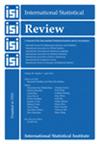Clustering Longitudinal Data: A Review of Methods and Software Packages
IF 1.8
3区 数学
Q1 STATISTICS & PROBABILITY
引用次数: 0
Abstract
SummaryClustering of longitudinal data is becoming increasingly popular in many fields such as social sciences, business, environmental science, medicine and healthcare. However, it is often challenging due to the complex nature of the data, such as dependencies between observations collected over time, missingness, sparsity and non‐linearity, making it difficult to identify meaningful patterns and relationships among the data. Despite the increasingly common application of cluster analysis for longitudinal data, many existing methods are still less known to researchers, and limited guidance is provided in choosing between methods and software packages. In this paper, we review several commonly used methods for clustering longitudinal data. These methods are broadly classified into three categories, namely, model‐based approaches, algorithm‐based approaches and functional clustering approaches. We perform a comparison among these methods and their corresponding R software packages using real‐life datasets and simulated datasets under various conditions. Findings from the analyses and recommendations for using these approaches in practice are discussed.纵向数据聚类:方法和软件包综述
摘要 纵向数据聚类在社会科学、商业、环境科学、医学和医疗保健等许多领域越来越受欢迎。然而,由于数据的复杂性,如随着时间推移收集到的观测数据之间的依赖性、缺失性、稀疏性和非线性,使得识别数据之间有意义的模式和关系变得十分困难。尽管聚类分析在纵向数据中的应用越来越普遍,但研究人员对许多现有方法的了解仍然较少,在选择方法和软件包方面提供的指导也很有限。在本文中,我们回顾了几种常用的纵向数据聚类方法。这些方法大致分为三类,即基于模型的方法、基于算法的方法和功能聚类方法。我们使用真实数据集和各种条件下的模拟数据集对这些方法及其相应的 R 软件包进行了比较。我们讨论了分析结果以及在实践中使用这些方法的建议。
本文章由计算机程序翻译,如有差异,请以英文原文为准。
求助全文
约1分钟内获得全文
求助全文
来源期刊

International Statistical Review
数学-统计学与概率论
CiteScore
4.30
自引率
5.00%
发文量
52
审稿时长
>12 weeks
期刊介绍:
International Statistical Review is the flagship journal of the International Statistical Institute (ISI) and of its family of Associations. It publishes papers of broad and general interest in statistics and probability. The term Review is to be interpreted broadly. The types of papers that are suitable for publication include (but are not limited to) the following: reviews/surveys of significant developments in theory, methodology, statistical computing and graphics, statistical education, and application areas; tutorials on important topics; expository papers on emerging areas of research or application; papers describing new developments and/or challenges in relevant areas; papers addressing foundational issues; papers on the history of statistics and probability; white papers on topics of importance to the profession or society; and historical assessment of seminal papers in the field and their impact.
 求助内容:
求助内容: 应助结果提醒方式:
应助结果提醒方式:


